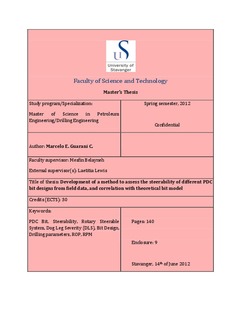| dc.contributor.author | Guarani, Marcelo | |
| dc.date.accessioned | 2014-02-06T09:26:13Z | |
| dc.date.issued | 2012 | |
| dc.identifier.uri | http://hdl.handle.net/11250/183668 | |
| dc.description | Master's thesis in Petroleum engineering | no_NO |
| dc.description.abstract | The bit and directional tool are a part of the BHA system. This thesis work analyzes that part of the system. The objective of the thesis is to analyze the performance of different bit designs using a computer simulator and field data.
In the introduction part, background information about PDC bits steerability concepts is given, the main objectives are stated and the scope and limitations are explained from a variable by variable considered approach.
The literature review covers important concepts such as the geological setting for this engineering study, the directional tool selected description of PDC bits design, definition of steerability and a description of all the variables considered in the analysis is given.
In this thesis work, a methodology for the analysis of bit performance is developed. The proposed methodology consists if five main steps. These are: Identification of Data Sources, Construction of the Main data Matrix, and Categorization and sorting of data, Simulation in DxDTM and Correlation of model.
The applicability of the method is tested on wells drilled in the Oseberg field. The results are presented in six case studies that consider the 8 ½’’ and 12 ¼’’ section. During the development of these cases studies, much meaningful insight was gathered, structured and presented here. In addition, the impact of different design features such as cutter structure, gage pad, sleeve gage length shape, among others was assessed and correlated with the simulator results.
The results from field case study and computer simulation shows that:
- The method developed was verified by the very different results that each steering behavior displayed. The walk tendency was disclosed when plotting the correlations for turning right and left.
- The positive impact of an active gage was verified, the importance of a flat profile was also seen in most of the cases as well as the improvement of reducing the number of blades of the sleeve to 4 and the addition of the MEG (modified Extended Gage) were also confirmed.
- The tilt length reduction also showed improvement in most bit designs.
Finally, since this is a very complex topic, it requires much more research to have a complete understanding of the behavior of the designed tools sunder subsurface conditions that encounters complex geological features. Some suggestions regarding the use of down-hole data available from special tools is presented and other possible approaches are listed in the suggestions part. | no_NO |
| dc.description.sponsorship | Halliburton AS. | no_NO |
| dc.language.iso | eng | no_NO |
| dc.publisher | University of Stavanger, Norway | no_NO |
| dc.relation.ispartofseries | Masteroppgave/UIS-TN-IPT/2012; | |
| dc.subject | petroleumsteknologi | no_NO |
| dc.subject | PDC Bit | no_NO |
| dc.subject | steerability | no_NO |
| dc.subject | rotary steerable system | no_NO |
| dc.subject | dog leg severity (DLS) | no_NO |
| dc.subject | bit design | no_NO |
| dc.subject | drilling parameters | no_NO |
| dc.subject | ROP | no_NO |
| dc.subject | RPM | no_NO |
| dc.title | Development of a method to assess the steerability of different PDC bit designs from field data, and correlation with theoretical bit model | no_NO |
| dc.type | Master thesis | no_NO |
| dc.subject.nsi | VDP::Technology: 500::Rock and petroleum disciplines: 510::Petroleum engineering: 512 | no_NO |
| dc.description.embargo | 2015-06-15 | |
